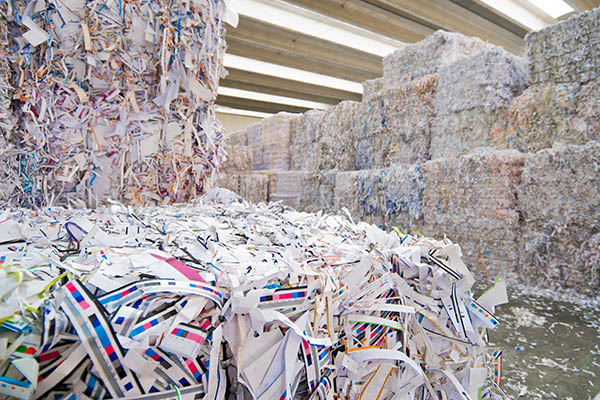In today’s increasingly digital world, going paperless is sometimes discussed as a way for organizations to improve their environmental footprints and demonstrate to their various stakeholders that they are environmentally responsible. Typically, these internal conversations focus on big-picture issues like forestry, greenhouse gas (GHG) emissions and waste disposal, and all too often are rooted in misconceptions about the environmental impacts of paper production and use. If your organization is considering these environmental issues as the basis for a paperless strategy, the question for your in-plant team becomes, “How do we demonstrate to management that print on paper is a truly sustainable choice, both today and in the future?”
The answer is simple: Show them the data.

First, let’s bust the myth that using paper causes deforestation and destroys forests. Every five years, the UN Food and Agriculture Organization (FAO) publishes its global Forest Resources Assessment which reports the state of the world’s forests. The 2020 FRA reports that net forest area in the United States grew by approximately 18 million acres between 1990 and 2020. That’s an area equivalent to around 1,200 NFL football fields every day!
So, is deforestation a real concern? Yes, but using paper is not the cause. The FAO defines deforestation as the permanent loss of forestland, whether it’s caused by humans or not. In fact, the definition specifically excludes logging for the production of wood, paper and other products because trees in these “working forests” are expected to grow back, either through natural generation or sustainable forestry practices. In the United States, the primary cause of deforestation is rapidly expanding urban development.
Despite deforestation that occurs on the local and regional level in the U.S. each year, net forest area has continued to grow thanks in great part to the sustainable forest management principles and practices followed by the paper industry and its suppliers. The USDA Forest Service reports that 58% of U.S. forestland is privately owned, and around 89% of the wood harvested each year, including most of the wood used for domestically produced paper products, comes from these private forestlands. Approximately 11 million families, individuals, estates and trusts, collectively referred to as family forest owners, control 36% of all private forestland, more than any other group.
Contrary to the myth that paper destroys forests, the continuing demand for sustainably sourced paper provides a financial incentive for private landowners not only to manage and harvest their acreage responsibly, but also to keep the land forested rather than converting it to non-forest uses. According to the Forest Service, tree harvesting occurs on less than 2% of U.S. forestland each year in contrast to the 3% disturbed annually by natural events like insects, disease and fire, and U.S. forests annually grow significantly more wood than is harvested.
Next, let’s debunk the myth that paper production is a major cause of greenhouse gas emissions that contribute to climate change. According to the most recent data available from the U.S. Environmental Protection Agency (EPA), industry is responsible for 22% of annual U.S. GHG emissions, and the pulp and paper industry is responsible for only 0.5% of total annual industrial GHG emissions. This low level of emissions is attainable because more than 65% of the energy demand at U.S. pulp and paper mills is met using renewable, carbon-neutral biomass. This, combined with continuing improvements in energy efficiency and a switch from oil and coal to other less carbon-intensive fuels like natural gas, enabled the industry to reduce GHG emissions by 23.2% between 2005 and 2018, according to the industry’s 2020 Sustainability Report published by the American Forest and Paper Association (AF&PA).

When it comes to reducing waste, paper recycling is an environmental success story. Based on industry data reported by AF&PA, the paper recycling rate has nearly doubled since 1990 thanks to voluntary industry efforts to build the commercial paper recovery infrastructure and to the commitment of millions of organizations and individual Americans who choose to recycle every day. At 66.2% in 2019, the U.S. paper recovery rate was higher than any other material in the country, including plastic, glass and metals. The recovery rate of corrugated cardboard packaging was 92%.

In 2019, recovered paper accounted for around 40% of total U.S. fiber consumption to make new paper products. Some may suggest that all paper products should contain 100% recycled content, but as a practical matter, that’s not possible. While paper can be recycled from five to seven times, the fibers eventually become too short and weak to bond into new paper. That’s why a continuous supply of fresh fiber from sustainably managed forests is needed to replenish the papermaking process.
Any organization considering a paperless strategy for sustainability reasons must recognize that digital technology is not without environmental impacts. The miniaturization of digital devices and the “invisibility” of the infrastructures needed to support them leads many to underestimate the environmental footprint of digital technology. This phenomenon is reinforced by the widespread availability of services on the “cloud,” which makes the physical reality of use all the more imperceptible and leads to underestimating the direct environmental impacts of digital technology.
Here are a few data points to consider:
- Computers and other electronic devices are made with non-renewable materials. The manufacture of a computer requires 240 kilograms of fossil fuels, 22 kg of chemicals, 1,500 kg of water and numerous precious (gold and platinum) and rare earth minerals (tantalum, lanthanum, neodymium, yttrium) as well as some that are dangerous for the environment ( lead, bromine, arsenic, chlorine, mercury and cadmium). L’Agence de l’Environnement et de la Maîtrise de l’Énergie, France, 2017
- Globally, the average number of electronic devices and connections per capita was 2.4 in 2017 and is expected to grow to 3.6 by 2023. In the United States, average per capita devices and connections are expected to reach 13.6 in 2023. Cisco, 2019
- Worldwide in 2019, the number of emails sent and received per day totaled over 293 billion (Radicati Group, 2019). With each email estimated to release .000001 metric tons of C02, total CO2 generated by emails globally is about 107 million metric tons per year (OVO Energy, 2019) or the equivalent amount of CO2 produced annually by 23 million cars. U.S. EPA, 2020
- The United States generates 6.9 million metric tons of e-waste annually and only 15% of that e-waste is recycled. Global E-waste Monitor, 2020
Digital technology has transformed our lives in many positive ways and may even be making beneficial contributions to your in-plant operations, but it also has wide-ranging environmental impacts that continue to grow. While all manufacturing processes have an environmental footprint, the fact that paper is made with an infinitely renewable resource (trees grown in sustainably managed forests), is manufactured using mostly renewable, carbon-neutral energy, is recyclable and is recycled more than any other material, makes a strong case for its continued use.
For more facts about the sustainability of print and paper, please visit www.twosidesna.org.

Kathi Rowzie
Vice President of Operations
Two Sides North America
Kathi Rowzie is an accomplished communications, public affairs and sustainability professional whose career spans more than 30 years in corporate and consulting roles with Fortune 500 companies, including extensive experience in the paper and forest products industry. Before joining Two Sides as Vice President of Operations in March 2020, she served for five years as vice president of communications and public affairs at Verso Corporation. During her previous paper industry career at International Paper she was both executive communications counsel to the chairman from 2013 to 2015 and communications leader for the company’s Printing and Communications Papers and Coated Papers businesses and their 12 paper mills from 2003 to 2006. Among her other responsibilities, she worked with many of the industry’s leading organizations, campaigns and coalitions, including Two Sides.
As a sustainability issues management and communications consultant, Kathi helped guide paper industry customers in the development of innovative sustainability strategies, programs, responsible paper procurement policies and communications, and in their response to the claims and demands of ENGOs. She has authored sustainability-related feature articles and more than a dozen CSR annual reports, and was instrumental in helping Two Sides North America launch many of its initial educational and marketing materials. She began her corporate career at GEICO, where for nearly a decade she was director of Business and Community Relations and led the company’s public relations, community relations and legislative action coalition building.
